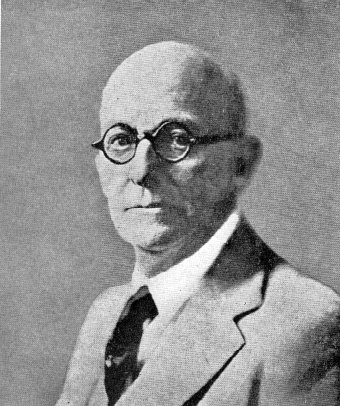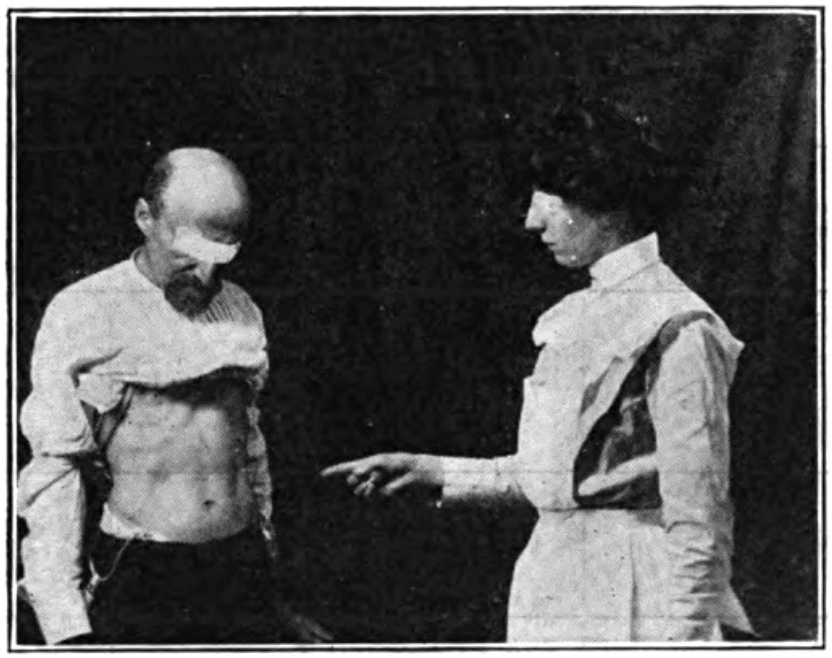Dr. Abrams had developed a very detailed procedure for physical diagnosis, with extensive use of percussion and palpation. He particularly emphasized percussion and found correlations between abnormal percussive sounds elicited from specific areas of the abdomen and pathology in particular parts of the body. To put it another way, he ascertained there were reflex connections between specific organs and particular areas of the abdomen. He found there were modifications in the sounds elicited by his percussion tests if syphilis, gonorrhea or TB were present.
The percussion tests had to be made while the patient was standing, facing a particular direction of the compass, with abdomen bared. Dr. Abrams' physical examination procedure was long and rigorous, and constituted something of an ordeal for patients who were quite ill. In an effort to make the examination easier for patients who were feeling too sick to stand for the required length of time, wires were connected from a metal band on the forehead of the patient to a similar band on the forehead of the healthy person, and from a metal plate in contact with the patient's feet, to another metal plate on which the healthy person stood with bare feet. With this hook-up Dr. Abrams found he could make his percussion and other tests upon the body of the healthy subject, and the subject then manifested all the disease reactions of the patient. Meanwhile the patient was reclining in comfort on a couch or sitting in a chair.
That the patient's disease reactions could manifest in the body of a healthy subject, when the two bodies were connected, showed that disease radiations and organ radiations would travel along conducting wires. Thus, no doubt unwittingly, the first step had been taken toward the development of a diagnostic circuit. In his search for methods to sharpen the sounds and thus make his percussion and palpation diagnosis more certain, Dr. Abrams tried the insertion of rheostats in one of the wires leading from the patient to a healthy subject.
The rheostat, a device used to control the amount of current flowing in electrical circuits, consisted of a coil of bare resistance wire wound around a tube or frame bent or formed into a curve. This usually encompassed the greater part of a circle. One end of the resistance wire constituted one of the contacts to the rheostat. The other contact was connected to a slider which by means of a [19] shaft and knob could be rotated. The arm of the slider made contact with the coil of resistance wire in such a way that by turning the knob, the number of turns of resistance wire in the circuit could be increased or decreased, depending on the direction of rotation of the knob and shaft.
DECIMAL READINGS OF INFINITY
The knob had a pointer, which pointed to a curved scale of position settings, on a board or panel. The dial settings of the rheostat showed, essentially, what proportion of the curved coil of resistance wire was included in the circuit. The scale was usually divided into divisions of zero to 100.
With one rheostat inserted into the connecting line between patient and healthy subject, it was found that with a patient who had syphilis, the sounds elicited by percussion on the abdomen of the healthy subject were considerably sharpened when the rheostat in the connecting line between the patient and the subject was set to the position of 55. Similarly, the percussion sounds on the healthy subject's abdomen were augmented by a setting of 52 if the patient suffered from gonorrhea. Likewise the percussion sounds elicited from the subject's abdomen were enhanced or augmented by a setting of 42, if the patient connected to the subject through the rheostat was a tubercular. Thus the principle of tuning in to disease was inaugurated. The original experimental work was done with these three diseases since their presence or absence could readily be determined by laboratory tests.
Other tunings were later added for additional diseases, such as flu, strep., staph., pneumonia, etc. Later the tuning range was increased by using two rheostats in series, providing for a total of 10,000 possible positions or settings. Many interesting and valuable discoveries were made by the use of this method; for example, reactions indicative of syphilis, gonorrhea or TB were elicited in patients who had once had one of these ailments, perhaps many years previous, though treatment had suppressed any outward evidence of the disease. The electronic reaction elicited by the Abrams method showed that the disease factor was still present in the body. It was found that in many instances, the patient's present complaints were eliminated or greatly alleviated when additional treatment was applied to finish clearing the syphilitic, gonorrheal or tubercular factor from the body.
In other cases a smaller or weaker reaction indicative of of one or more of these three basic diseases was elicited in patients who had no medical history of any of those ailments; upon investigation it was learned that a parent or grand-parent or previous ancestor had manifested the ailment for which the electronic reaction was elicited in the descendant. Here again, the health of the patient improved a great deal when treatment eliminated the reaction characteristic of those three basic diseases.
The inheritance of a tissue taint by the descendants of those who suffered from venereal disease or TB is reminiscent of Dr. Samuel Hahnemann's "chronic miasmas". Dr. Hahnemann was the founder of Homeopathy. The principle of inherited toxins is thus well known to homeopaths. For them it is a concept accepted on faith, a point of doctrine; but to the electronic or radionic practitioner it is a demonstrated fact. This fact points toward improving health in a way that orthodox medicine cannot provide, since orthodoxy does not recognise the underlying condition.
(To be continued.)
* * *
A RADIONICS-LOCATED GOLD STRIKE IN SOUTHERN CAL?
Escondido, Calif. "Free Press", Aug. 22, 1968: "The nearby mountain community of Julian could be in for a stampede like the famous gold rush of nearly 100 years ago. John Collins, 75, part-owner of the Ella Group Mines on Banner Grade, revealed this week the results of an assay of March 1968. The report, by a Los Angeles firm, indicated an excellent per-ton yield, not only of gold, but of another more valuable metal -- platinum!
"'We've known it was here,' Collins said in his cabin beside Hiway 78. 'Miners have encountered it in varying amounts through the years but they always ignored it, not knowing what it was . . .'
"Collins said his motivation in announcing the platinum strike was to call attention to the effectiveness of a metal locating device operated by himself and his partner, Howard Luhring. Geologists have known for some time that there's still plenty of gold left in 'them thar hills. The only trouble is first, you've got to locate it, and second, get it out.' The first problem, Collins claims, is easily solved by means of his device. 'Wit it, we hope to solve the second problem. We're for hire to other mines to locate valuable minerals. With fees earned, we'd like to buy some new milling and processing equipment to get the stuff out.'
"When pressed for a description of his locating device, Collins was mum. Finally he said, 'I'd rather not reveal the details of how it works, except to say it's nothing new. It was originated in Europe years ago to find water and coal deposits. We adapted it to our purpose . . . Not exactly like water-witching, though it's similar. There are no electronic circuits or batteries. I can't tell you how it works. I can say, though, that it's based on the affinity of similar elements. Each metal reacts to a similar signal. The operator has to be mentally in accord with the operation . . . We operated our locator on a trial and error basis for years, but now I can say it's finally perfected. It's so accurate that even though some ore samples we locate with it show no gold at first, a later assay will verify the findings of the locator. Some persons who try to operate the device can't. Others get a reverse polarity reading. All the elements in the universe are in the human body, and maybe that has something to do with how it works . . ."
Continue with "The History and Development of Radionics" (Part III)

Further Reading
- Abrams, Albert. New Concepts in Diagnosis and Treatment: Physico-clinical Medicine, the Practical Application of the Electronic Theory in the Interpretation and Treatment of Disease: with an Appendix on New Scientific Facts. San Francisco, Calif: Philopolis Press, 1916. Print. [Digital: <http://catalog.hathitrust.org/Record/001588073>; reprints are available through BSRF in our classic xerographic format: <#B0210, "New Concepts in Diagnosis and Treatment">]
- Abrams, Albert. Human Energy. San Francisco: Philopolis Press, 1914. Print. [Digital: <http://catalog.hathitrust.org/Record/008904901>; reprints are available through BSRF in our classic xerographic format: <#B0211, "Human Energy">]
- Abrams, Albert. Spondylotherapy: Physio and Pharmacotherapy and Diagnostic Methods Based on a Study of Clinical Physiology. San Francisco: Philopolis Press, 1914. Print. [Digital: <http://catalog.hathitrust.org/Record/002089090>; reprints are available through BSRF in our classic xerographic format: <#B0177, "Spondylotherapy">]
An introductory review of Abrams and his work can be found in
"ERA: Electronic Reactions of Abrams" (#B0025).

